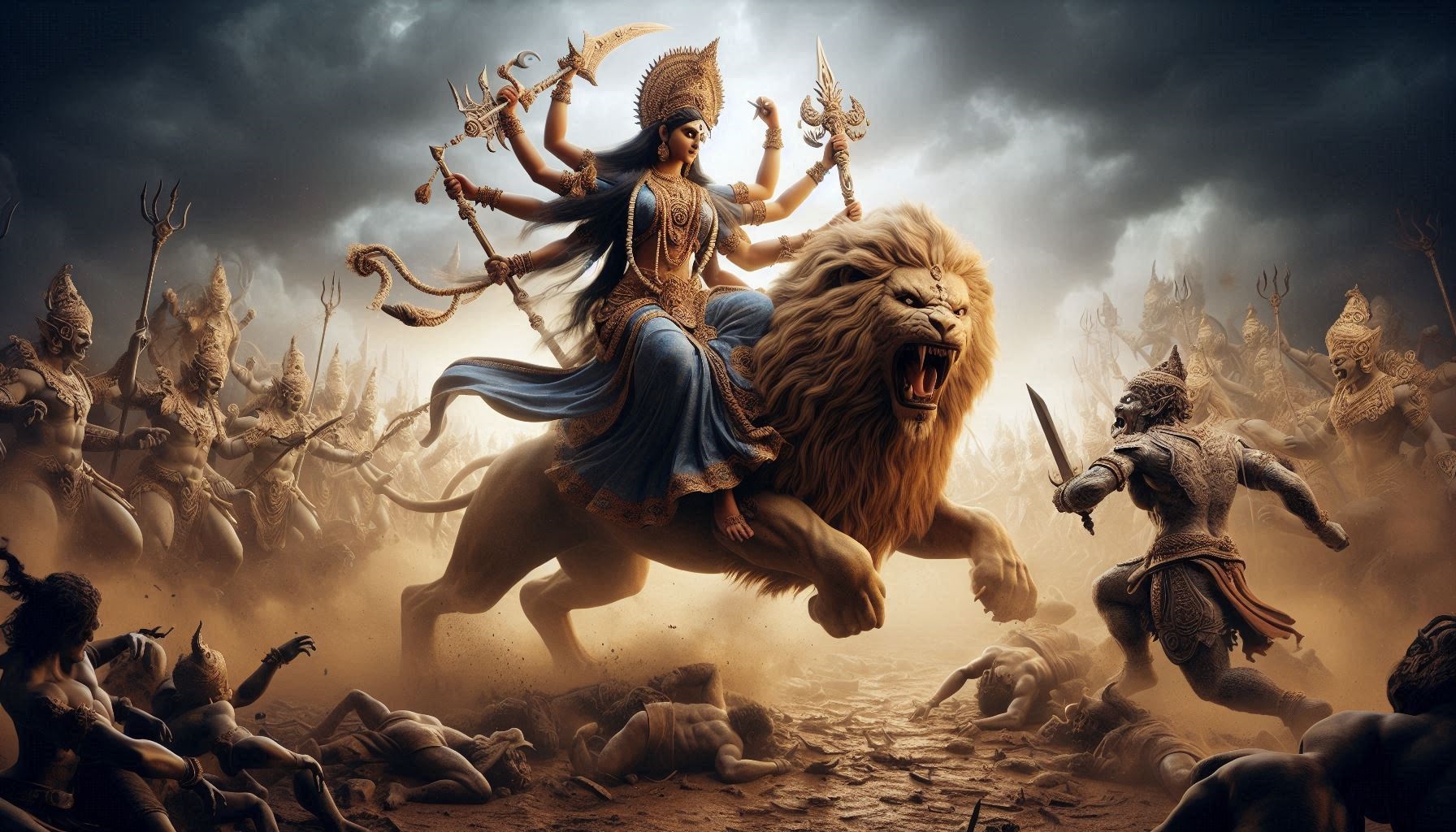The story of epic battle between Goddess Durga and Mahishasura (the demon king), a struggle that symbolizes the victory of good over evil, which is celebrated annually as Dussehra (Vijayadashami). This tale not only explains the origins of the festival but also highlights Durga’s role as a protector and restorer of cosmic harmony.
The Rise of Mahishasura

Mahishasura, born from the union of the demon king Rambha and a buffalo named Mahishi, was no ordinary demon. He was part man, part buffalo, embodying both cunning intelligence and brute strength. Empowered by a boon from Lord Agni, he could only be slain by a woman, making him nearly invincible. Confident in his immunity, Mahishasura’s ambitions grew beyond earthly rule. He aspired to control both heaven and earth, believing himself untouchable by any mortal or god.
Mahishasura’s tyranny spared no realm. He and his army of demons launched relentless assaults, conquering the heavens and dethroning the king of gods, Indra. The celestial realms were thrown into chaos, and gods were driven from their abodes. The anguish of gods and sages reached a peak as Mahishasura continued his violent rampage, mocking the deities and dismissing their authority.
The Creation of Goddess Durga
In desperation, the gods gathered to seek the counsel of the trinity—Brahma, Vishnu, and Shiva. Recognizing that only a woman could vanquish Mahishasura, they united their energies, combining their divine powers to create a supreme goddess who would possess all their strengths.
From this confluence of power arose Goddess Durga, her radiance illuminating the cosmos. Clad in red and adorned with gold jewelry, she was majestic, emanating the strength of all the gods combined. Each god contributed their mightiest weapon to aid her in battle. Shiva gave her his trident, Vishnu his discus, and Indra his thunderbolt, while others gifted her bows, arrows, a sword, and a powerful lion to serve as her mount. Armed and ready, Durga personified cosmic strength, embodying the power needed to restore balance.
The Epic Battle Between Durga and Mahishasura

Durga descended to earth to face Mahishasura. Her very presence instilled fear in the hearts of the demon king’s followers. But Mahishasura, blinded by his arrogance, underestimated her. At first, he sent his demon generals to confront her, but she defeated them effortlessly, one after another. Realizing he could no longer avoid the battle, Mahishasura himself came forward, determined to destroy her.
A fierce battle ensued. Mahishasura’s shape-shifting abilities allowed him to constantly change form, attempting to outmaneuver the goddess. First, he attacked in his buffalo form, charging at her with immense force. Durga struck him down, but he rose again, morphing into a lion, then a giant man with a sword, and then into an enormous elephant. With each transformation, Durga met him with equal power, unrelenting in her mission. Her attacks were precise, and her strength unwavering. She was the embodiment of divine fury, fighting to restore order.
As the battle raged on for days, Durga finally pinned Mahishasura down as he took the form of a buffalo once again. With a fierce cry, she drove Shiva’s trident into his heart and decapitated him with her sword, putting an end to his tyranny. The cosmos stilled, and a sense of peace and balance returned to the universe. The gods, freed from the threat of Mahishasura, showered Durga with praise and flowers, expressing their gratitude for her courage and strength.
The Significance of Vijayadashami (Dussehra)
This triumph became a symbol of the victory of dharma (righteousness) over adharma (unrighteousness), celebrated as Vijayadashami or Dussehra each year. The festival marks not only the end of Durga’s battle with Mahishasura but also serves as a reminder of the protection and justice that divine forces bring. Goddess Durga’s victory continues to inspire, reminding devotees to stand firm against wrongdoing and to uphold the values of courage and righteousness.

